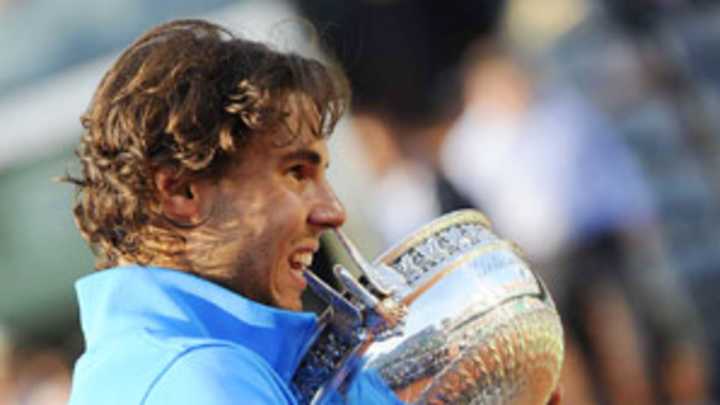Why do so many athletes kiss trophies? They play hard to get


This week, when Rafa Nadal nibbled an ear of the French Open cup, and Dwyane Wade canoodled with the Larry O'Brien trophy in an NBA Finals ad, and the Bruins and Canucks fought over who gets to fill the Stanley Cup with champagne and take it on vacation, it seems reasonable to ask: Are these trophies or trophy wives?
There's a long, chaste tradition of athletes kissing trophies, of golfers and tennis players planting one on their newly won silverware. What the television viewer doesn't hear during those ceremonies are the photographers, standing in a pack like spectators at a royal wedding, impatiently calling for a kiss -- "Kiss the trophy!" -- until at last the reluctant couple complies.
Rafa's ear-nuzzle is a nice Euro-touch, but it only works on jug-handled prizes. Silver plates and Olympic medals get bitten, the way Underdog used to bite the coin when receiving payment for a shoeshine. The NBA trophy is often dipped like a dance partner, held the way Clark Gable holds Vivien Leigh in the poster for Gone With The Wind.
Once mere symbols of achievement, the trophy is becoming the end in itself. They are objects of desire, with rituals of courtship, capable of receiving affection and capable of withholding it. Mavericks guard Jason Terry has a tattoo of the Larry O'Brien trophy on his right biceps, where once a sailor might have tattooed his sweetheart's name. If the Mavericks don't win that trophy in the coming days, Terry says he'll have the tattoo removed, as any spurned suitor would do.
The greatest romance between man and trophy remains Michael Jordan and the Larry O'Brien, who began their relationship in 1991 with a scene so moving -- MJ in tears, cradling the trophy, to which he was connected at the forehead and seemingly at the soul -- that watching it, even now, seems strangely voyeuristic.
If not the first, Jordan was certainly the most famous athlete to look lovingly and longingly at the trophy -- as all players do now, if only because they see their own images in its golden skin. This, literally, is reflected glory.
And so they toast it, hug it and take it out on the town. And when an overly exuberant athlete accidentally drops it off the upper deck of an open-air bus -- as Sergio Ramos of Real Madrid did with the Copa del Rey in April -- many hands intervene to nurse a trophy back to health.
"I kissed it, hugged it, I probably want to sleep with it," Packers receiver Donald Driver told the Fort Worth Star-Telegram immediately after this year's NFC championship game. "But they ain't going to let me do that." And he was just talking about the George Halas trophy. Contrast this with the NHL, whose penultimate prizes -- the Prince of Wales and Clarence Campbell trophies -- go untouched by players who are, in a manner of speaking, saving themselves for marriage.
It's a wonder more don't. Why an athlete who has just exhausted him or herself in competition, and won an oversized novelty check for $2 million, will comply with photographers' requests to kiss and/or nibble the trophy is beyond me. But the custom is now so firmly established -- whether it's movie stars with their Oscars or doubles teams double-teaming a silver serving tray -- that asking is becoming unnecessary.
The night his team won the Super Bowl, Saints coach Sean Payton slept with and -- in his words -- probably drooled on" the Lombardi Trophy. He also danced with it during the Saints parade in New Orleans. Likewise when Liverpool won the Champions League in 2005, Steven Gerrard slept with the European Cup. Bryan Trottier and his wife slept with the Stanley Cup after the Islanders won it in 1980, and one can hardly blame them for doing so.
The Stanley Cup is still the most glamorous trophy in existence, idealized in part because it's largely unattainable. When actress Hayden Panetierre was photographed hugging, kissing, licking and throwing a leg around it in 2008, the trophy appeared entirely unmoved. If anyone was entitled to use the ancient pickup line, "Do you want to see my etchings," it is the Stanley Cup. But to its credit, it simply sat in silence.
That's because the Stanley Cup is used to such advances. It's routinely filled with champagne, taken out to dinner, chauffeured to the beach, toured around Europe, flown by private jet and squired with white gloves down red carpets. It plays more than hard-to-get, as the Bruins and Canucks can attest this week. It plays very-nearly-impossible to get.
It's only natural, then, that these trophy wives have spawned inflatable substitutes. The NBA Finals are often graced by a giant inflatable Larry O'Brien trophy. The Super Bowl has featured an inflatable Lombardi Trophy, tethered like a zeppelin lest it take flight. If you can't have the actual Stanley Cup, you can have -- for forty bucks, purchased online -- an inflatable Stanley Cup to keep you company.
Sad? Certainly. But it's as close as you're likely to get to the real thing.
